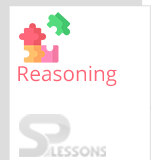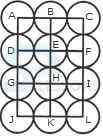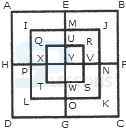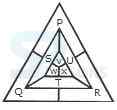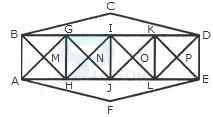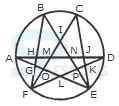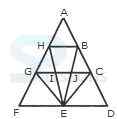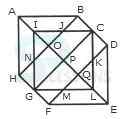 Introduction
Introduction
Analytical Reasoning skills are crucial in every field that involves Numerical Reasoning, Logic, Math , Deductions & Inductions and fields where data needs to be analysed to discern patterns within the data. Analytical Reasoning is thus defined as the ability to look at the data/information and to find patterns or rules or connection between items in the information. Analytical Reasoning questions in competitive exams include both verbal & non-verbal questions and also involve a series of diagrams and pictures.
The article Analytical Reasoning Practice Quiz 2 lists different types of Analytical Reasoning questions with solutions useful for candidates preparing for different competitive examinations like RRB .RRB ALP/Technical Exams/Junior Engineer Recruitment Exams, SSC CGL,SSC CHSL, IBPS, SBI PO, SBI Clerks, CAT and etc.
 Quiz
Quiz
1. Count the number of triangles and squares in the given figure.
- A. 26 triangles, 5 squares
B. 28 triangles, 5 squares
C. 26 triangles, 6 squares
D. 28 triangles, 6 squares
- A. 3
B. 4
C. 5
D. 6
- A. 28 triangles, 3 squares
B. 24 triangles, 5 squares
C. 28 triangles, 5 squares
D. 24 triangles, 3 squares
- A. 20
B. 18
C. 16
D. 12
- A. 6
B. 7
C. 8
D. 1
1. Count the number of squares in the given figure.
- A. 32
B. 30
C. 29
D. 28
- A. 6
B. 7
C. 9
D. 11
- A. 8
B. 12
C. 15
D. 18
- A. 6
B. 5
C. 4
D. 3
- A. 36 triangles, 7 squares
B. 38 triangles, 9 squares
C. 40 triangles, 7 squares
D. 42 triangles, 9 squares
1. Find the number of triangles in the given figure.
- A. 8
B. 10
C. 12
D. 14
- A. 16
B. 17
C. 18
D. 19
- A. 22
B. 24
C. 26
D. 28
- A. 12
B. 18
C. 22
D. 26
- A. 18
B. 20
C. 24
D. 27
Other Articles
 Study Guide
Study Guide
 Exams
Exams
| Competitive Exams - College Entrance Exams | |||
|---|---|---|---|
| Category | Notification | ||
| Diploma | NITC New Delhi | Goa Diploma Admissions 2019 | |
| Click Here For – All India Entrance Exam Notifications | |||
 Daily CA
Daily CA
 Job-Alerts
Job-Alerts
 SP Quiz
SP Quiz
| Competitive Exams - Practice Sets | |
|---|---|
| Category | Quiz |
| Quant Aptitude | Time and Work |
| Reasoning Ability | Puzzles |
| Current Affairs | Current Affairs |
 GK
GK
| General Knowledge for Competitive Examinations | |
|---|---|
| Topic | Name of the Article |
| GK - World | North America Countries Capitals Currencies |
| World Tribal Groups | |
| GK - India | Indian History Timeline – Quick Read |
| First Indians | |
| GK - Abbreviations | Finance Abbreviations |
| Computer Aptitude Abbreviations | |
| GK - Banking & Insurance | Indradhanush Strategy to Revamp PSU Banks |
| Indian Banking Structure | |
| GK - Science & Technology | Phobias List |
| Medical Science Discoveries | |
| Father of Different Fields – Science & Technology | |
